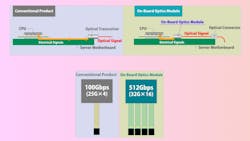Prototype On-Board Optics Module Hits Record Bandwidth, Cuts Data-Center Power Use
The Overview
Kyocera Corp. has developed an on-board optics module that achieves world-record bandwidth of 512 Gb/s. The module is expected to support high-speed network applications, such as data centers. In addition, the module decreases power consumption over conventional alternatives and will promote sustainability.
Who Needs It & Why?
Artificial intelligence, the IoT, and 5G services create enormous demand for internet traffic and fast, high-bandwidth data centers. As a result, the data-center industry is becoming a power hog. Reducing the power consumption of these facilities is paramount for environmental and infrastructure concerns.
Because Kyocera’s on-board optics module features a miniaturized form factor that enables mounting the device inside servers and near CPUs, the devices can instantaneously convert data signals into optical signals. Unlike conventional optical modules that include relatively long runs of copper conductors, the prototype eliminates much of that copper, improving signal-to-noise ratio and signal losses (see figure, top).
Under the Hood
The largest bandwidth among on-board optics on the market today is 100 Gb/s. Kyocera’s module achieves a world-record 512-Gb/s bandwidth, over 5X greater than conventional products, while consuming just 9 W (equivalent to 18 mW/Gb/s). Such large bandwidth is possible because the module uses the company’s low-temperature co-fired ceramic (LTCC) mounting substrate, which offers material characteristics such as fine wiring, low dielectric constant, multilayering, and thermal conductivity.
Measuring a mere 43.5 × 30 × 8.1 mm (except for four pairs of fiber-optic arrays), the module delivers its world-record bandwidth in a limited space, carrying 16 channels of 32 Gb/s/channel (see figure, bottom). The device’s electrical interface comprises high-speed, high-density connector plugs for power and signal lines. Its optical interface comprises four sets of eight-channel multimode optical fibers, each set carrying four channels of optical signal transmission and reception.
Kyocera is continuing to test this technology with partner companies to achieve commercialization as early as possible.
About the Author
David Maliniak
Executive Editor, Microwaves & RF
I am Executive Editor of Microwaves & RF, an all-digital publication that broadly covers all aspects of wireless communications. More particularly, we're keeping a close eye on technologies in the consumer-oriented 5G, 6G, IoT, M2M, and V2X markets, in which much of the wireless market's growth will occur in this decade and beyond. I work with a great team of editors to provide engineers, developers, and technical managers with interesting and useful articles and videos on a regular basis. Check out our free newsletters to see the latest content.
You can send press releases for new products for possible coverage on the website. I am also interested in receiving contributed articles for publishing on our website. Use our contributor's packet, in which you'll find an article template and lots more useful information on how to properly prepare content for us, and send to me along with a signed release form.
About me:
In his long career in the B2B electronics-industry media, David Maliniak has held editorial roles as both generalist and specialist. As Components Editor and, later, as Editor in Chief of EE Product News, David gained breadth of experience in covering the industry at large. In serving as EDA/Test and Measurement Technology Editor at Electronic Design, he developed deep insight into those complex areas of technology. Most recently, David worked in technical marketing communications at Teledyne LeCroy, leaving to rejoin the EOEM B2B publishing world in January 2020. David earned a B.A. in journalism at New York University.


